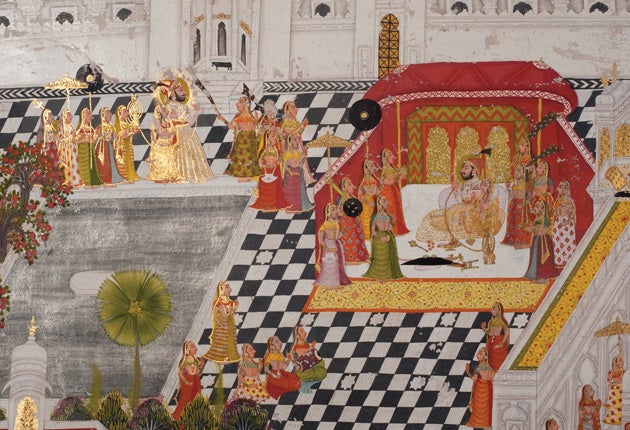Maharaja: the splendour of India's Royal Courts, V&A, London

It would be difficult to find a more visually ravishing show than this one in the whole of London. The objects – from palm leaf fronds on the end of tapering silver stems to cool an emperor's brow, to the silver accoutrements of an elephant; from gorgeous Indian miniatures showing shapely young female royals depending, languorously, from the end of a kite, to paintings of tremendous royal processions that seem to go on and on and on, at such a languid pace, until we run out of wall space – are dazzling, and the setting, from first to last, coyly razzmatazz.
The exhibition is all about the unbridled royal splendour of India from about the time of the collapse of the Mughal Empire in the 18th century to independence day. So we are talking about a period of approximately 250 years, years when Europe was beginning to turn its collective mind towards a future of mechanised industrialisation and, ultimately, democracy.
Seen within that ideological context, this level of crushing, awe-inspiring, people-humbling opulence feels weirdly anachronistic, as if this display of quasi-divine set-apartness should have been at its height hundreds of years before. It also feels strangely unreal for another reason. We can scarcely believe that the entire spectacle of the exhibition itself is not a cunning fiction of some kind because it seems, set down as it is in this most elegant of Victorian interiors, to lack almost everything that we know India to be, and to have been: the dust, the teeming, hands-thrusting million upon million who never stop coming at you, even when you are locked inside the very finest, shiniest Mercedes tour bus that Cox & Kings can ever hope to provide.
Yes, we all pick our way, with such restraint and politesse – as if we are almost obliged to ape the behaviour of the courtiers whose rulers we are here to gawp at – around this strange, odourless universe of royal opulence. Even two school girls, sketching in silence, politely moved aside when I strained to read the details of one particularly tiny palanquin. We find ourselves almost sighing over its passing, somehow sympathising with all that went on before a canny lawyer called Mahatma Gandhi turned all those millions of utterly impoverished nobodies into mobilisable somebodies.
To 17 January 2010 (020-7942 2000)
Subscribe to Independent Premium to bookmark this article
Want to bookmark your favourite articles and stories to read or reference later? Start your Independent Premium subscription today.

Join our commenting forum
Join thought-provoking conversations, follow other Independent readers and see their replies